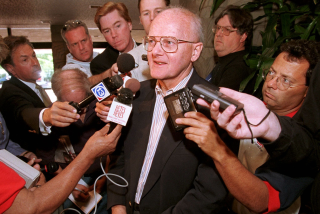Wireless Becoming Tool to Link Machines
- Share via
For years, wireless communications has been about communicating between people. Now it’s starting to be about communications between machines.
The focus increasingly is on ways to make your home computer talk to your stereo, your Handspring Visor talk to your cell phone and your cell phone talk to the cash register at Taco Bell.
In fact, at this week’s Consumer Electronics Show, there were just as many people talking about wireless technologies that connect devices as there were people talking about the devices themselves.
“We’re in the infancy of all of this, but everyone is discovering that the wireless experience is where they want to be,” said Ronald Garriques, a general manager in Motorola’s personal communications unit. “Everybody wants a piece of this . . . and it will drive an unbelievable amount of creativity.”
Many companies believe that mobile phones and other hand-held portables should help us all buy more stuff more quickly and conveniently.
U.S. consumers soon will be able to use their mobile phones to automatically pay for a pizza or buy a chalupa.
It may sound silly, but fast food is a $100-billion business in the United States, and executives at McDonald’s and Kentucky Fried Chicken are keenly interested in anything that could get customers through their lines faster.
Mobile phone giant Nokia is testing a system in Raleigh, N.C., that uses a unique identifier embedded in the phone, giving it the ability to make a payment much the way toll-road drivers pay the required fee every time their transponder-equipped cars pass a designated reader.
Not to be outdone, Motorola is launching “Pizzacast,” a venture that allows users to wirelessly order a pizza by scrolling through custom menus, selecting thin or thick crust, the desired toppings and so forth. The service, announced this week, works on Web-enabled devices and essentially makes an Internet-based transaction.
Palm CEO Carl Yankowski demonstrated that he could buy several items from Sharper Image using a new payment system based on infrared signals and an “embedded Visa card.”
“We believe that hand-helds will do for wireless information what the Walkman did for music and the cell phone did for voice communication,” he said.
Yankowski and others also hailed the emergence of a technology known as Bluetooth, which can wirelessly connect as many as 10 devices within 30 feet or so. Only a few Bluetooth-enabled devices are for sale today, but the necessary radio chip is relatively cheap and frugal with power, and in a year the technology will be included in many mobile phones, in laptop, hand-held and desktop computers, and in printers, kitchen appliances, watches and more.
With Bluetooth, headsets for mobile phones and portable radios no longer need wires, and the same goes for computer keyboards and mouses. Digital cameras can send images to any Bluetooth device without cables of any kind.
One of the earliest uses for Bluetooth will be to enable cell phones, laptops and hand-helds to share information and Internet connections at high speed--more than 700,000 bits per second. That would allow someone with a Bluetooth-enabled mobile phone to leave the phone in a pocket or briefcase while dialing into the Web on a Bluetooth-equipped laptop.
3Com, for one, will begin selling Bluetooth adapters for notebook computers in August for about $120.
Prodded by the computer industry, Bluetooth and other wireless systems are quickly moving into the home to connect all manner of devices into a digital network. In addition to Bluetooth, at least three other wireless approaches were on display at the vast electronics show.
Elsewhere at the show, companies unveiled new experiments in bringing together hand-held computers and mobile phones--sometimes as one unit and sometimes using wireless connections as a link.
Little-known FutureCom Global of Las Vegas continued to wow tech lovers with its PC ePhone, a PDA with sleek styling and just about everything you’d ever want: a beautiful color display, wireless Internet access, text messaging and e-mail, bar code scanning, infrared, wireless printing, add-on ports for location-finding units and digital cameras, Microsoft applications, calendar-type functions, and . . . a wireless phone.
Kyocera’s latest phone/PDA entry is a greatly improved phone with flip-open PDA functions for an expected price tag of less than $500. Motorola, meanwhile, was showing off its new V100, a teen-cool oversized flip-open pager with a tiny keyboard and wireless phone built in and accessible through a headset--available in a few months at less than $250.
Samsung and Seiko also drew crowds with new techno-watches that have a slew of PDA functions built in along with a Dick Tracy-style wireless phone. The Samsung watch phone browses the Web, has voice-activated dialing and will be sold by Sprint PCS in a few months for about $500.
“What’s great is that all of these manufacturers are willing to invest in these devices so that we will really find out what people like and will really use,” said Paul Hiles of Compaq. “We’re going to have a massive fan-out of devices in the coming years.”
*
Times staff writer Elizabeth Douglass covers telecommunications. Staff writer Jon Healey contributed to this report.






